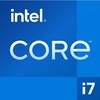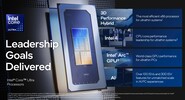Intel Core i5-14500HX vs Intel Core Ultra 5 135H
Intel Core i5-14500HX
► remove from comparison
The Intel Core i5-14500HX is a high-end CPU from the Raptor-Lake-HX Refresh series (RPL-H). The CPU offers all 6 performance cores (P-cores, Golden Cove or Raptor Cove architecture) and 8 efficiency cores (E-cores, Gracemont architecture). The P-cores support hyperthreading (therefore 20 threads together) and clock from 2.4 to 4.9 GHz (single-core turbo). The E-cores clock from 1.9 - 3.7 GHz and should offer comparable performance to old Skylake cores (e.g. i7-6920HQ).
Performance
Thanks to the higher clock rates of the Rocket Lake series, the i5-14500HX can reach the level of the old Core i9-12900H and is therefore a very fast mobile CPU that is ideal for all areas of application.
Graphics unit
Like its predecessor, Intel integrates an Intel Xe-based graphics unit. In the 14500HX, all 96 EUs are activated and clock at up to 1.55 GHz.
Features
Like Alder-Lake-H, Raptor-Lake-H has partially integrated WiFi 6E and Thunderbolt 4 (4x). The integrated memory controller now supports faster DDR5-5200 memory. The integrated Gaussian and Neural Accelerator (GNA) is still installed in version 3.0. The Quick Sync 8 media engine is the same as in Rocket Lake and supports MPEG-2, AVC, VC-1 decode, JPEG, VP8 decode, VP9, HEVC and AV1 decode. The chip supports PCIe 5.0 x8 for a dGPU and two PCIe 4.0 x4 for SSDs. The PCH also offers PCIe Gen3 x12.
Power consumption
The Intel Core i5-14500HX is specified with 55 watts TDP (PL2 157 watts). The processor continues to be manufactured using the improved Intel 7 process (10 nm SuperFin).
Intel Core Ultra 5 135H
► remove from comparison
The Intel Core Ultra 5 135H is a mid-range Meteor Lake family chip that debuted in December 2023. This 1st Gen Core Ultra processor has come to replace 13th generation Core processors; it has 14 cores (4 + 8 +2) and 18 threads at its disposal. Its Performance cores, of which there are 4, are HT-enabled and run at up to 4.6 GHz while its Efficient cores, of which there are 10 (8 main cores plus 2 extra ones found in the Low Power Island) run at up to 3.6 GHz. The 8-core Arc GPU, just out of the oven, serves as the integrated graphics adapter - this runs at up to 2.20 GHz - and there is a bevy of other brand-new technologies on offer as well such as the integrated AI Boost NPU with two Gen 3 engines for hardware AI workload acceleration.
Architecture and Features
With Meteor Lake, Intel intends to deliver higher CPU performance, higher GPU performance and at the same time, longer battery life than what Raptor Lake chips were capable of. The company also wants a large piece of the AI cake and is working with Microsoft and other partners to make that happen. As a result, Windows Defender is now AI-enabled, meaning it can use the Intel NPU to take some of the load off the main CPU cores. We also get this new Intel Device Discovery technology that is designed to give us a better hardware-based remote laptop management than ever before; and, to make things even better, Intel now offers a dedicated Arc Pro graphics driver for workstations.
This generation of Intel Core processors features Redwood architecture P-cores and Crestwood architecture E-cores. Both come with slight architectural improvements over Raptor Cove and Gracemont respectively for slightly higher performance-per-clock figures; the interesting thing is that of the 10 E-cores, two are actually a separate cluster located on what Intel calls a "Low Power Island". Essentially, the latter is an SoC within an SoC that can stay active while most other parts of the chip are temporarily switched off to save power. The low-power E-cores run at up to 2.5 GHz. Intel hopes this approach will let it deliver unprecedentedly low power consumption figures when under low load, boosting battery life of laptops and tablets powered by Meteor Lake.
To build its Meteor Lake processors, Intel uses the Foveros technology (stacking several chips on top of each other). This is a cost-cutting measure more than anything else, as manufacturing several small dies on several different processes is so much cheaper than making a huge single die and hoping that there are no defects in it that will require disabling some parts of it.
Elsewhere, the Core Ultra 5 135H comes with 18 MB of L3 cache which is a significant reduction compared to the 24 MB that the 155H, the 165H and the 185H have. The processor has a very healthy number of PCIe 5 and PCIe 4 lanes for NVMe SSD speeds up to 15.7 GB/s; it supports RAM running at up to 7467 MHz (DDR5-5600, LPDDR5-7467, LPDDR5x-7467, to be specific - which is about as good as what 8040 series Ryzen chips have). vPro Enterprise and business-centric features such as the Remote Platform Erase are onboard as well. Naturally, the 135H also features built-in Thunderbolt 4 support and Intel CNVi Wi-Fi support. It is also worth mentioning that Intel chose to keep native SATA III support that AMD had removed from its Ryzen processors quite a while ago.
The 135H is compatible with 64-bit Windows 10, 64-bit Windows 11 and with many Linux distros.
Performance
While we have no way of knowing what the 135H will be like, as of December 2023, it's safe to expect the chip to be at least as fast as the Ryzen 7 7735HS (Zen 3 Plus, 8 cores, 16 threads, up to 4.75 GHz), as far as multi-thread performance is concerned.
Either way, real-world performance of the chip may vary significantly depending on how high the CPU power limits are and how competent the cooling solution of the system is.
Graphics
The 8-core Arc GPU running at up to 2.20 GHz is set to give the Radeon 780M something to think about. The Arc is set to be miles ahead of aging Xe-series integrated GPUs. As long as one chooses to take Intel's word for it, that is.
A proper DX12 Ultimate graphics adapter, the Arc is no stranger to ray tracing and other modern technologies including AI frame generation (XeSS). It will let you connect up to four SUHD 4320p monitors and it will both HW-encode and HW-encode the most widely used video codecs including AVC, HEVC and AV1 in a fast and efficient manner.
Your mileage may vary depending on how high the CPU power limits are, how competent the cooling solution of your system is, how fast the RAM of your system is. The latter is really important; Intel stresses that for the Arc to deliver the best results possible, multi-channel RAM configuration is a must.
Power consumption
This Core Ultra 5 series processor has a Base power consumption of 28 W, while its Turbo power consumption is not supposed to exceed 115 W. Its Base power consumption is supposed to be around 64 W, however, most laptop makers will probably go for a higher value to get higher clock speeds and thus higher performance. Either way, a powerful cooling solution will be needed to sort out this chip's hot temper.
The 135H is comprised of five small chips ("tiles") that are connected using Intel's Foveros technology. The tile containing main CPU cores is produced on the fairly modern 7 nm Intel process marketed as Intel 4 while most other tiles (the iGPU, the I/O die, ...) are built with TSMC's N5 and N6 processes. The base tile is built with the old Intel 22FFL process.
| Model | Intel Core i5-14500HX | Intel Core Ultra 5 135H | ||||||||||||||||||||||||||||||||||||||||
| Series | Intel Raptor Lake-HX | Intel Meteor Lake-H | ||||||||||||||||||||||||||||||||||||||||
| Codename | Raptor Lake-HX Refresh | Meteor Lake-H | ||||||||||||||||||||||||||||||||||||||||
| Series: Meteor Lake-H Meteor Lake-H |
|
| ||||||||||||||||||||||||||||||||||||||||
| Clock | 1800 - 5000 MHz | 3600 - 4600 MHz | ||||||||||||||||||||||||||||||||||||||||
| L3 Cache | 24 MB | 18 MB | ||||||||||||||||||||||||||||||||||||||||
| Cores / Threads | 14 / 20 8 x 4.9 GHz Intel Raptor Cove P-Core 8 x 3.5 GHz Intel Gracemont E-Core | 14 / 18 4.6 GHz 4 x 3.6 GHz Intel Redwood Cove P-Core 8 x 2.5 GHz Intel Crestmont E-Core 2 x Intel Crestmont E-Core | ||||||||||||||||||||||||||||||||||||||||
| TDP | 55 Watt | 28 Watt | ||||||||||||||||||||||||||||||||||||||||
| TDP Turbo PL2 | 157 Watt | |||||||||||||||||||||||||||||||||||||||||
| Technology | 10 nm | 7 nm | ||||||||||||||||||||||||||||||||||||||||
| max. Temp. | 100 °C | 110 °C | ||||||||||||||||||||||||||||||||||||||||
| Socket | BGA1744 | BGA2049 | ||||||||||||||||||||||||||||||||||||||||
| Features | DDR4-3200/LPDDR4x-4266/DDR5-5200/LPDDR5-6400/LPDDR5x-6400 RAM, PCIe 5, Thr. Dir., DL Boost, GNA, MMX, SSE, SSE2, SSE3, SSSE3, SSE4.1, SSE4.2, AVX, AVX2, BMI2, ABM, FMA, ADX, SMEP, SMAP, EIST, TM1, TM2, HT, Turbo, SST, AES-NI, RDRAND, RDSEED, SHA | DDR5-5600/LPDDR5-7467/LPDDR5x-7467 RAM, PCIe 5, Thr. Director, DL Boost, AI Boost, vPro Enerp., RPE, MMX, SSE, SSE2, SSE3, SSSE3, SSE4.1, SSE4.2, AES, AVX, AVX2, AVX-VNNI, FMA3, SHA | ||||||||||||||||||||||||||||||||||||||||
| iGPU | Intel Iris Xe Graphics G7 96EUs ( - 1550 MHz) | Intel Arc 8-Core iGPU ( - 2200 MHz) | ||||||||||||||||||||||||||||||||||||||||
| Architecture | x86 | x86 | ||||||||||||||||||||||||||||||||||||||||
| Announced | ||||||||||||||||||||||||||||||||||||||||||
| Manufacturer | ark.intel.com | ark.intel.com |
Benchmarks
* Smaller numbers mean a higher performance
1 This benchmark is not used for the average calculation


 Deutsch
Deutsch English
English Español
Español Français
Français Italiano
Italiano Nederlands
Nederlands Polski
Polski Português
Português Русский
Русский Türkçe
Türkçe Svenska
Svenska Chinese
Chinese Magyar
Magyar